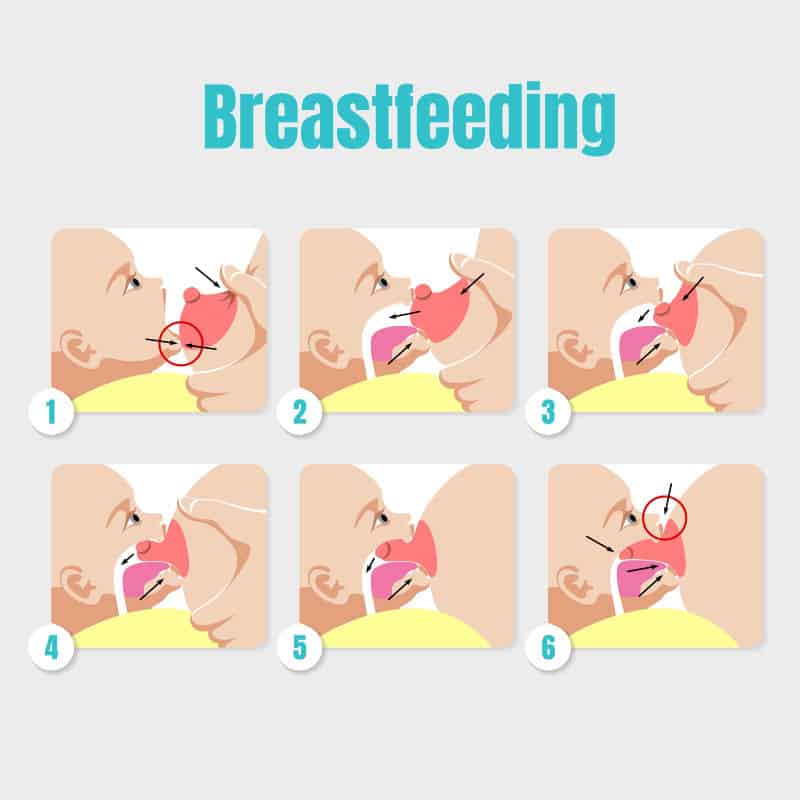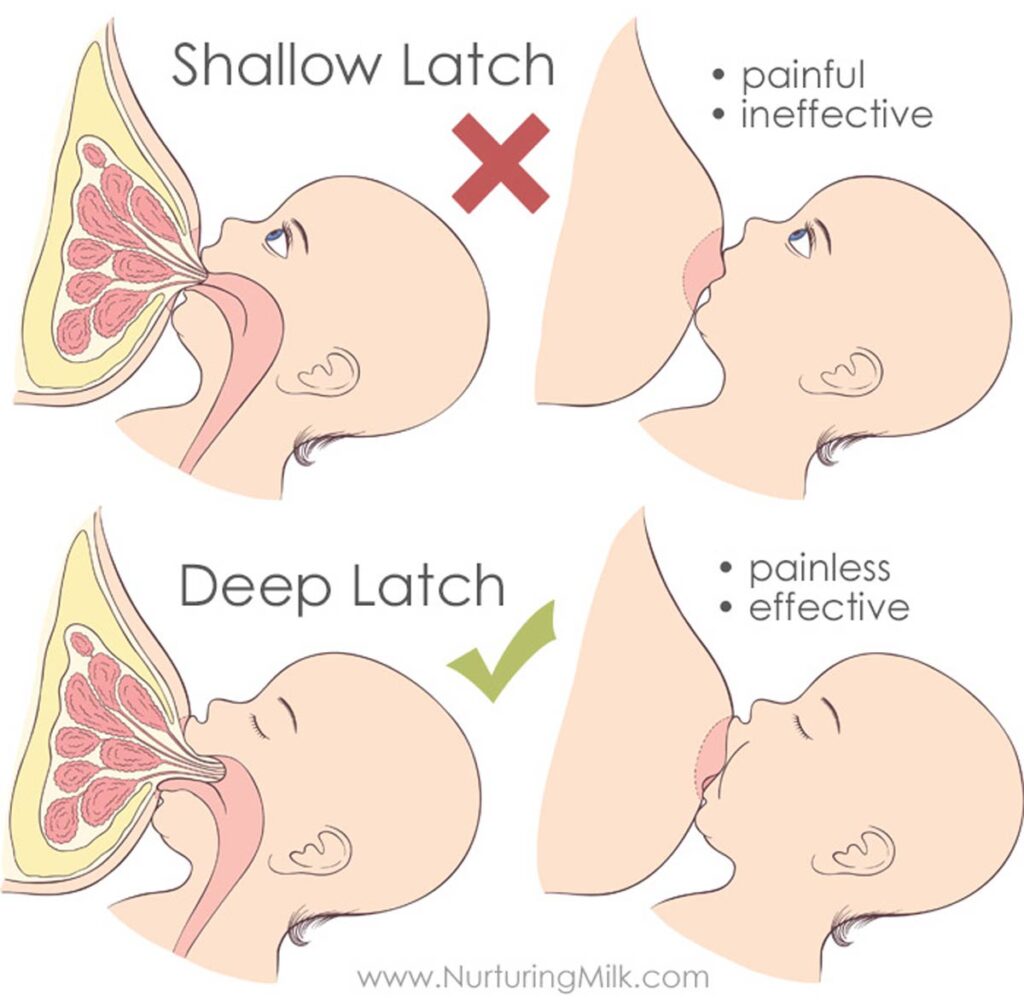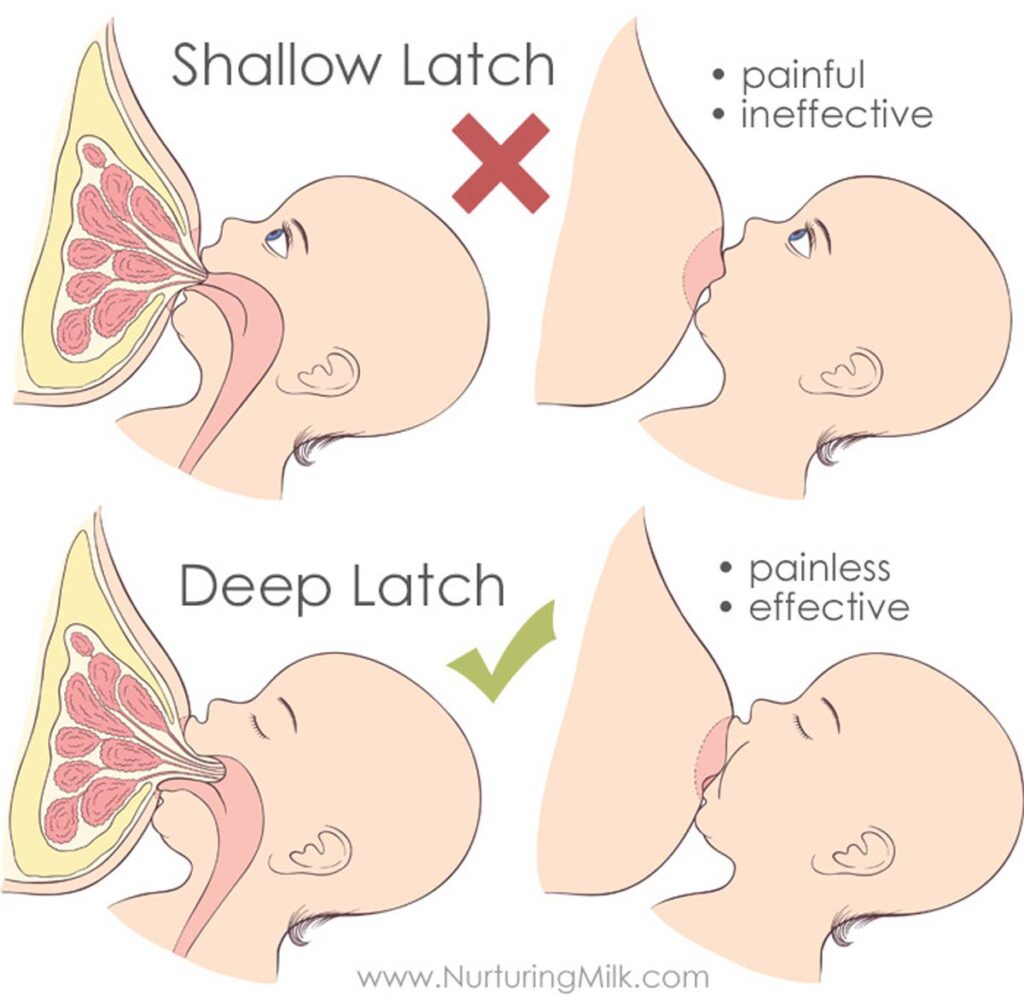So, you’ve embarked on the wonderful journey of breastfeeding, but finding the perfect latch seems to be a bit challenging. No worries, dear friend! In this article, we’ll explore the world of correct latching techniques. Whether you’re a new mom or simply seeking a refresher, we’ve got you covered. Get ready to discover the secrets to a comfortable and successful breastfeeding experience for both you and your little one. Let’s dive right in and unlock the magic of proper latching!
The Importance of Proper Latching
Understanding the significance of correct latching
When it comes to breastfeeding, proper latching is crucial for both mom and baby. It ensures that the baby gets enough milk and receives the necessary nutrition for their growth and development, while also helping to prevent common breastfeeding issues such as sore nipples and low milk supply. Additionally, proper latching promotes a strong bond between mom and baby, as it allows for skin-to-skin contact and encourages closeness during feeding sessions.
Benefits of proper latching for both mom and baby
Proper latching offers numerous benefits for both mom and baby. For the baby, it ensures effective milk transfer, leading to optimal nutrition and weight gain. It also reduces the chances of swallowing excess air, which can cause discomfort and colic. Additionally, babies who latch correctly are less likely to experience problems like nipple confusion, tongue-tie, and shallow latch.
For moms, proper latching helps stimulate milk production, leading to an adequate milk supply. It also reduces the risk of engorgement, mastitis, and blocked milk ducts. Moreover, correct latching can minimize nipple pain and soreness, making breastfeeding a comfortable and enjoyable experience for both mom and baby.
Signs of Incorrect Latching
Recognizing the indicators of improper latching
It’s important to recognize the signs of incorrect latching to address any issues promptly. Some common signs include nipple pain or discomfort, flattened or misshapen nipples after feeding, clicking noises while breastfeeding, and a baby who gets easily frustrated or agitated during feeding sessions. Additionally, if a baby is not gaining weight adequately or seems unsatisfied after feedings, it may be an indication of improper latching.
Common issues associated with incorrect latching
Improper latching can lead to a range of issues, affecting both mom and baby. Some common problems include nipple soreness, cracked or bleeding nipples, poor milk transfer, inadequate weight gain, and decreased milk supply. It can also contribute to a decreased desire to breastfeed, as moms may associate the experience with pain and discomfort. Therefore, understanding and addressing any issues related to latching is essential for successful breastfeeding.


Preparation for Successful Latching
Creating a comfortable environment for breastfeeding
Before attempting to latch your baby, it’s important to create a comfortable environment for breastfeeding. Find a quiet and peaceful space where you and your baby can relax without distractions. Ensure the room is well-lit, as it will help you see what you’re doing and make adjustments if needed. You may also want to have some breastfeeding essentials nearby, such as pillows for support and a glass of water to stay hydrated.
Positioning yourself and your baby for successful latching
Proper positioning is key to achieving a good latch. Start by making yourself comfortable, whether you’re sitting or lying down. Use pillows to support your back, arms, and baby if needed. Position your baby facing your breast, with their chest and belly touching yours. Their head should be in line with their body, not tilted or turned to the side. Supporting your breast with one hand, gently guide your baby’s mouth to your nipple.
Step-by-Step Guide to Correct Latching
Preparing your breast for the latch
Before latching, it’s important to ensure your breast is ready. Start by washing your hands thoroughly to maintain hygiene. Check for any signs of engorgement, such as a swollen and firm breast. If your breast is engorged, use gentle massage or warm compresses to soften it before feeding. Expressing a small amount of milk by hand or using a breast pump can also help facilitate the latch by making it easier for your baby to grasp the nipple.
Engaging your baby’s natural reflexes
Babies have several natural reflexes that can aid in successful latching. These include the rooting reflex, which prompts them to turn their head towards a stimulus (in this case, your nipple), and the sucking reflex, which encourages them to open their mouth automatically. To engage these reflexes, gently stroke your baby’s cheek or lower lip with your nipple. This should trigger their instinct to turn towards the nipple and open their mouth wide.
Proper alignment of baby’s mouth
When your baby opens their mouth wide, it’s crucial to align their mouth properly with your nipple. Aim to position your nipple towards the roof of their mouth, rather than towards the tip of their tongue. This ensures that they can latch onto the areola, the dark area around the nipple, and not just the nipple itself. A wider latch on the areola provides better milk flow and reduces the risk of nipple pain and damage.
Ensuring a deep latch
A deep latch is essential for effective milk transfer and preventing nipple soreness. To achieve a deep latch, encourage your baby to open their mouth wide by using gentle pressure against their lower lip with your breast. As they open their mouth, bring them close to your breast so that their chin touches it first. This will help them take in more of the areola and ensure a deep latch. Make sure their lips are turned outward, forming a flanged shape, and not tucked inwards.
Monitoring the latch during breastfeeding
Once your baby is latched, pay attention to their feeding cues and monitor the latch throughout the breastfeeding session. Look for signs of rhythmic sucking and swallowing, as this indicates that your baby is effectively transferring milk. If you feel any discomfort or pain during breastfeeding, gently break the latch and try again. It’s also important to switch sides during feedings to ensure both breasts are emptied and your milk supply remains balanced.


Common Challenges and Solutions
Dealing with nipple pain and discomfort
Nipple pain and discomfort are common breastfeeding challenges, often caused by an improper latch. However, there are several techniques to alleviate the pain. Start by ensuring a deep latch, as a shallow latch can place unnecessary strain on the nipple. Applying lanolin or a nipple cream after each feeding can help soothe sore nipples. It’s also essential to allow your nipples to air dry after feeding and to wear loose clothing to reduce friction. If the pain persists, consult a lactation consultant for additional support and guidance.
How to address an ineffective latch
If you notice that your baby is not latching effectively, there are steps you can take to improve the latch. Start by breaking the latch gently and then reposition your baby, ensuring that they are properly aligned with your breast. Engage their natural reflexes by stimulating their cheek or lower lip with your nipple. Supporting your breast with one hand, guide your baby’s mouth towards your nipple, aiming for a deep latch. If you continue to struggle with latching, seek assistance from a lactation consultant.
Overcoming difficulties with latching
Difficulties with latching can be frustrating, but remember that patience and persistence are key. Take your time to experiment with different breastfeeding positions and techniques to find what works best for you and your baby. Utilize the support of a lactation consultant or join a breastfeeding support group to receive guidance and encouragement. Remember that latching is a learned skill for both mom and baby, and with practice, it can become easier and more comfortable over time.
Supportive Techniques for Successful Latching
Utilizing proper breastfeeding positions
Finding the right breastfeeding position can greatly enhance latching success. Some commonly recommended positions include the cradle hold, cross-cradle hold, football hold, and reclining position. Experiment with different positions to determine which one is most comfortable and effective for you and your baby. Remember to support your baby’s head, neck, and back, ensuring that their body is aligned with yours for easy latching.
Encouraging a strong suck
A strong suck is essential for effective milk transfer and optimal nutrition for your baby. To encourage a strong suck, gently stroke your baby’s lower lip or chin when they are latched. This will trigger their sucking reflex and stimulate them to suck more vigorously. You can also use breast compression techniques, gently squeezing your breast as your baby suckles, to increase milk flow and stimulate their sucking response.
Implementing skin-to-skin contact
Skin-to-skin contact provides numerous benefits for both mom and baby, including promoting successful latching. During breastfeeding, try to have your baby’s skin directly against yours. This closeness helps regulate your baby’s body temperature, stabilizes their heart rate and breathing, and triggers their feeding reflexes. Skin-to-skin contact also releases oxytocin, the hormone responsible for milk let-down, making it easier for your baby to latch and for you to produce milk.
Seeking assistance from a lactation consultant
If you are experiencing persistent difficulties with latching or if you simply want additional guidance and support, don’t hesitate to seek assistance from a lactation consultant. These professionals are trained in breastfeeding techniques and can provide personalized advice tailored to your specific situation. They can assess your baby’s latch, address any underlying issues, and offer practical strategies to improve latching success. A lactation consultant can be a valuable resource on your breastfeeding journey.


Maintaining a Good Latch
How to keep a good latch throughout the breastfeeding session
Once you have achieved a good latch, it’s important to maintain it throughout the breastfeeding session. To do so, ensure that your baby’s mouth remains wide open and their lips are flanged outwards. Monitor their feeding cues, such as rhythmic sucking and swallowing, to ensure they are effectively transferring milk. If you feel any discomfort, gently break the latch and reposition your baby, aiming for a deep latch again. As you and your baby become more experienced with breastfeeding, maintaining a good latch will become second nature.
When and how to break the latch
Breaking the latch is necessary when breastfeeding sessions are finished or when you need to switch sides. To break the latch, gently insert your finger into the corner of your baby’s mouth to release the suction. This will allow you to remove your breast without causing any discomfort to your baby. While breaking the latch, support your baby’s head and continue to hold them close to you to maintain that emotional connection. If your baby falls asleep during feeding, gently break the latch to wake them up and ensure they are fully satisfied.
Balancing Milk Supply and Latching
Proper milk supply regulation
Achieving a balance between milk supply and latching is important for successful breastfeeding. Your milk supply is regulated by a combination of supply and demand. The more your baby breastfeeds with a good latch, the more milk your body produces. It’s important to breastfeed frequently, especially in the early weeks, to establish a healthy milk supply. If you’re concerned about your milk supply, seek guidance from a lactation consultant who can assess your situation and provide appropriate recommendations.
Handling challenges related to low or overactive milk supply
Some moms may face challenges related to milk supply, either having low milk supply or an overactive let-down. If you’re dealing with low milk supply, ensure that your baby is effectively latched and breastfeeding frequently. You can also try techniques such as pumping after feedings to stimulate milk production. On the other hand, if you have an overactive let-down, try positioning your baby upright during feedings or using breast compression techniques to regulate milk flow. Again, a lactation consultant can provide personalized guidance to address specific milk supply challenges.


Common Myths about Latching
Dispelling misconceptions related to latching
There are several common misconceptions about latching that can create unnecessary worries and hinder breastfeeding success. One common myth is that if your baby is latching well, you shouldn’t feel any discomfort. In reality, it’s normal to experience some mild tenderness during the first few seconds of latching, but it should not be intense or painful. Another myth is that mothers with small or inverted nipples cannot breastfeed successfully. However, with proper latching techniques and support, all moms can breastfeed regardless of nipple size or shape.
Separating fact from fiction
To ensure successful breastfeeding, it’s important to separate fact from fiction when it comes to latching. Fact: A good latch is essential for effective milk transfer. Fiction: Nipple size or shape determines breastfeeding success. Fact: Latching may be uncomfortable initially, but it should not be painful throughout the feeding session. Fiction: Breastfeeding should always be painless. Fact: Latching takes practice and patience, and seeking support can make a significant difference. Dispelling these myths allows you to approach breastfeeding with confidence and clarity.
Additional Resources and Support
Useful websites, books, and videos about correct latching
There is a wealth of resources available to help you learn more about correct latching techniques and address any difficulties you may encounter. Websites such as La Leche League International, KellyMom, and the American Academy of Pediatrics offer in-depth articles, videos, and resources on breastfeeding and latching. Books such as “The Womanly Art of Breastfeeding” by La Leche League International and “Breastfeeding Made Simple” by Nancy Mohrbacher and Kathleen Kendall-Tackett provide comprehensive information on correct latching techniques. Additionally, YouTube channels like Global Health Media and Stanford Medicine’s Newborn Nursery offer helpful videos demonstrating proper latching.
Finding support groups and breastfeeding communities
Joining a support group or breastfeeding community can be invaluable on your breastfeeding journey. These groups provide a safe space to share your experiences, seek advice, and connect with other moms who may have faced similar challenges. La Leche League International and Mother-to-Mother Support are two well-known organizations that offer local group meetings and online support forums. Additionally, many hospitals and birthing centers have breastfeeding support groups or lactation consultants on-site who can provide guidance and expertise. Remember, you don’t have to navigate breastfeeding alone – there are many resources available to support you.


